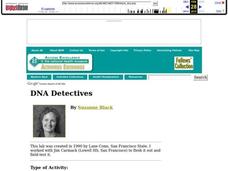Curated OER
Hair Test
In this forensic science worksheet, students write an answer to 1 open response question about a given hair evidence collected from the crime scene.
Curated OER
Hair Test
In this forensic science worksheet, students write an open response to 3 questions posed about hair evidence in the crime scene. They explain where and why the samples are most likely found.
Curated OER
Who Took Jerell's iPod?
Students investigate various substances to determine the perpetrator of a crime. In this biology lesson, students test for the presence of organic compounds in various samples. They identify an unknown substance based on its physical and...
Curated OER
Forensic Examination of Artifacts: The Mystery of Meriwether Lewis' Death
Students role play the position of a scientist to gather information on Meriwether Lewis' death. They discover what he did after the famous expedition and how centuries affect the study of a body. They share their information with the...
Curated OER
Trace Evidence
In this trace evidence learning exercise, students use the websites on the forensic science page of the kid zone at http://sciencespot.net/ to complete the fill in the blank questions on the learning exercise.
Curated OER
The Case of Similar Substances
Middle schoolers perform tests in the lab to identify an unknown substance. In this physical science lesson, students observe the physical and chemical properties of substances. They formulate a conclusion based on experimental results.
Curated OER
Fingerprinting
In this fingerprinting worksheet, students write short answers to 16 questions about the principles of fingerprinting. They explain how this method is used to identify criminals.
Curated OER
DNA Fingerprinting
Students study the process of DNA Fingerprinting and how DNA Fingerprinting is used in solving crimes. They examine a crime scenario that involves collecting DNA Fingerprinting information from blood collected at the crime scene. They...
Curated OER
DNA Detectives
In order to understand DNA fingerprinting, advanced biology aces divise a crime scenario and analyze three different samples of lambda DNA. This creative lesson plan provides practice with micropipettes, electrophoresis boxes, and other...
Curated OER
Innocent or Guilty: A Lab on DNA Gel Electrophoresis
Students use the prelab as an introduction to the importance of DNA fingerprinting- a form of identification that us being accepted by both scientific and leagl experts. They prepare a gel for electrophoresis. DNA fragments, which have...
Curated OER
Handwriting and Forgery
Students determine how forensics analyze handwriting samples. In this physical science instructional activity, students research how handwriting analyses help solve their assigned cases. They prepare a skit and present it in class.
Curated OER
Blood Analysis
Learners reconstruct a crime scene to produce the blood spatter pattern. In this forensic science lesson, students describe the events that lead to produce such patterns. They explain the importance of blood analysis in solving crimes.
Curated OER
Crime Scene Investigation (CSI) with Powdery Mildew Fungi
Young scholars explore a specific method of identifying fungi, using a written key and an illustrated key. Powdery mildew fungi can be identified to genus by the morphology (appearance) of the sexual stage (cleistothecia).
101 Questions
Bone Collector
Feel like a detective yet? Pupils first watch a brief clip from the movie The Bone Collector. Using a photo of the suspect's footprint next to a dollar bill, they then use proportions to determine the size of the suspect's shoe.
Curated OER
Murder Mystery
High schoolers examine how to capture foot prints while they simulate a criminal investigation. They discover how the clues are needed for identifying or eliminating murder suspects.
Shmoop
ELA - Literacy.CCSS.ELA-Literacy.RST.9-10.6
Key to understanding scientific or technical texts is identifying the underlying question the author is attempting to answer. Provide your young scientists with an opportunity to practice identifying these questions and the procedures...
Curated OER
Careers in Chemistry
Students watch a video about careers in chemistry. In this Chemistry lesson plan, students will research chemistry careers and chose one to do further research on.
Curated OER
Fingerprinting
Young scholars list and describe the three types of fingerprint patterns. They list and describe three layers of fingerprints that can be made. They explain why we leave fingerprints.
Curated OER
Ink Analysis and Thin Layer Chromatography
Students explain the process of TLC. They identify at least three components of ink. They analyze data and make conclusions based on laboratory observations.
North Carolina State University
Exploring Genetics Across the Middle School Science and Math Curricula
Where is a geneticist's favorite place to swim? A gene pool. Young geneticists complete hands-on activities, experiments, and real-world problem solving throughout the unit. With extra focus on dominant and recessive genes, Punnett...
Curated OER
Archaeological Detectives
Young scholars, in groups, examine in depth one aspect of forensic archaeology to determine the skeleton's age, gender, and possible cause of death. To do so, students must first explain what is involved in each aspect of forensic...
Curated OER
Genetics 5 Technology
Learners, after studying extraction and gel electrophoresis, recombinant DNA, transgenic organisms, and reproductive cloning, summarize the main concepts in DNA technology. They analyze the applications of DNA: forensics, medicine,...
Curated OER
Lewis and Clark in Columbia River Country
Students interpret historical evidence presented in primary and secondary resources. In this research skills lesson, students research the death of Meriwether Lewis using forensic evidence presented in primary...
Curated OER
Flipping Coins: Density as a Characteristic Property
Young scholars explore linear functions in a crime solving context. They collect and analyze data using linear equations, then interpret the slope and intercepts from a linear model.

























